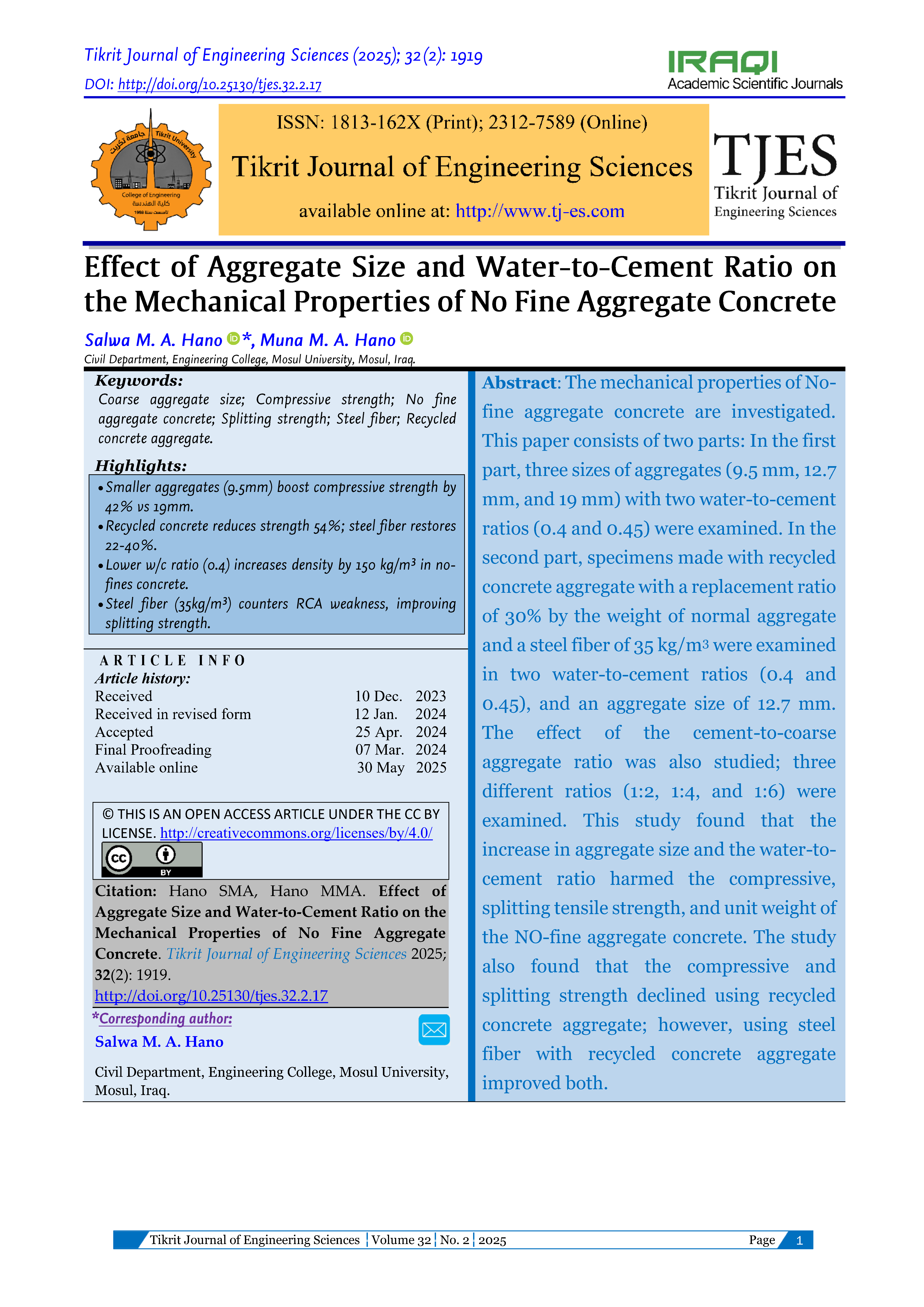Effect of Aggregate Size and Water-to-Cement Ratio on the Mechanical Properties of No Fine Aggregate Concrete
Main Article Content
Abstract
The mechanical properties of No-fine aggregate concrete are investigated. This paper consists of two parts: In the first part, three sizes of aggregates (9.5 mm, 12.7 mm, and 19 mm) with two water-to-cement ratios (0.4 and 0.45) were examined. In the second part, specimens made with recycled concrete aggregate with a replacement ratio of 30% by the weight of normal aggregate and a steel fiber of 35 kg/m3 were examined in two water-to-cement ratios (0.4 and 0.45), and an aggregate size of 12.7 mm. The effect of the cement-to-coarse aggregate ratio was also studied; three different ratios (1:2, 1:4, and 1:6) were examined. This study found that the increase in aggregate size and the water-to-cement ratio harmed the compressive, splitting tensile strength, and unit weight of the NO-fine aggregate concrete. The study also found that the compressive and splitting strength declined using recycled concrete aggregate; however, using steel fiber with recycled concrete aggregate improved both.
Article Details
Section

This work is licensed under a Creative Commons Attribution 4.0 International License.
THIS IS AN OPEN ACCESS ARTICLE UNDER THE CC BY LICENSE http://creativecommons.org/licenses/by/4.0/
References
Maguesvaria MU, Narasimha VL. Studies on Characterization of Pervious Concrete for Pavement Applications. Procedia - Social and Behavioural Sciences 2013; 104:198-207.
Ghafoori N, Dutta S. Laboratory Investigation of Compacted No-Fines Concrete for Paving Materials. Journal of Materials in Civil Engineering 1998; 7(3).
Schaefer VR et al. An Overview of Pervious Concrete Applications in Storm Water Management and Pavement System. Iowa State University; 2006.
US Environmental Protection Authority. Storm Water Management Handbook. 2009; 45.
Kuennen T. A New Era for Porous Pavement: Better Road for the Government Project. 2003.
Abadjieva T, Sephiri P. Investigations on Some Properties of No-Fines Concrete. 2000.
Rehman HAA. Some Properties of Fiber Reinforced No-Fine Concrete. Al-Qadisiya Journal for Engineering Sciences 2012; 5(4):439-450.
Thombre KB. Investigation of Strength and Workability in No-Fines Concrete. International Journal of Engineering Research & Technology 2016; 5(9):390-393.
Patil PS, Sonar IP, Shinde S. No-Fine Concrete. International Journal of Concrete Technology 2017; 3(2):1-13.
Al-Luhybi A, Al-Sulayfani B. Strengthening and Rehabilitation of Concrete Prisms Using GFRP Sheet. Al-Rafidain Engineering Journal 2020; 25(1):17-23.
Iraqi Standard Specifications. Portland Cement. I.Q.S No.5; 2010.
Iraqi Standard. Water for Making Concrete. I.Q.S No.1703; 2016.
ASTM International. Standard Test Method for Density, Absorption, and Voids in Hardened Concrete. *ASTM C642-13*; 2013.
British Standards Institution. Method for Determination of Compressive Strength of Concrete Cubes. BS 1881 Part 116; 1989.
Geissert DG, Li SE, Frantz GC, Stephens EJ. Splitting Prism Test Method to Evaluate Concrete-to-Concrete Bond Strength. ACI Materials Journal 1999; 96(3): 359-366.





